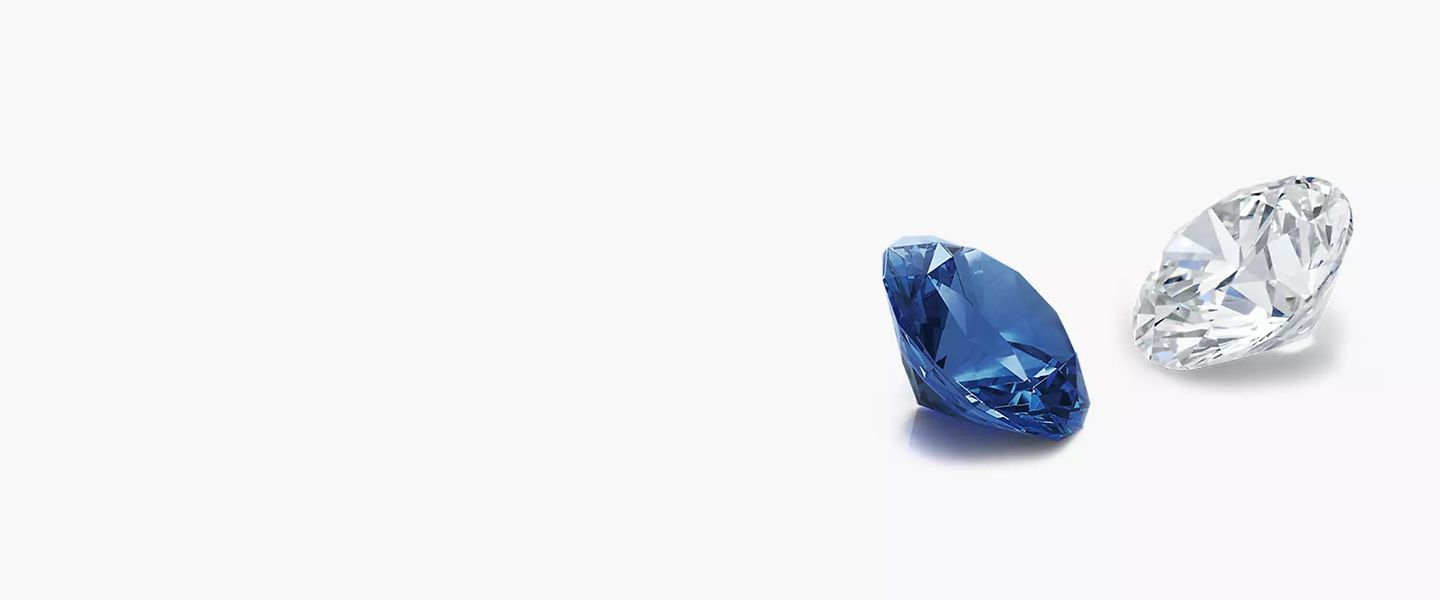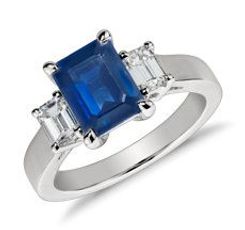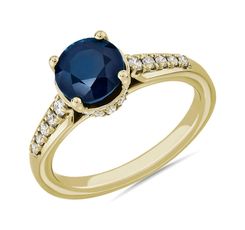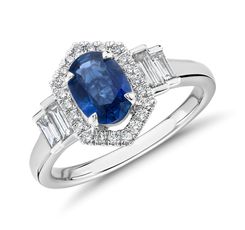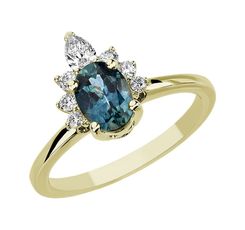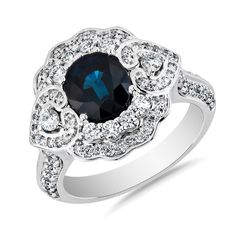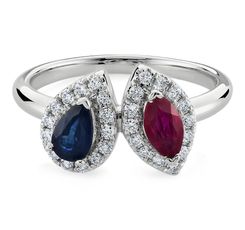DETAILS >
Origins, History and Rarity
It’s true that diamonds are rare and precious stones, but it’s the distinct color, clarity, carat and cut of each particular diamond that defines its individuality. Diamonds have been mined for over two millennia, with the first stones coming from India. Now, diamonds are found around the world, with the majority sourced in Canada, Australia, Africa and Russia. There are also lab made diamonds entering the jewelry space.
Diamonds have historically commanded attention as priceless shining stones. Starting in India’s rivers and streams during the 4th century, diamonds found their way to Europe where they were the elite’s favorite fashion starting in the 1400s. Since then, diamond demand has exploded globally and the trade has been reformed with conflict-free diamonds.
Sapphires are made of the mineral corundum, and high-quality sapphires can be even rarer than diamonds. They are also mined around the world, with notable mines in South-East and Central Asia, Australia, Africa and the U.S. in Montana. Traditionally, sapphires are available in blue and white, though additional colors are available.
Historically, sapphires have been worn by royalty for centuries. Ancient Greek and Roman kings and queens would use blue sapphires to protect themselves from harm.
Appearance
Clear, radiant diamonds and cool, blue sapphires are highly recognizable gemstones. However, both of these stones come in a wide array of colors and offer an eye-catching variety in appearance.
When comparing white sapphires to more colorless diamonds, there are some main differences between these two stones. Diamonds will typically appear more sparkly than sapphires of similar qualities because of the differences in how these stones reflect light. In smaller sizes, the differences are typically less apparent.
Brilliance
Diamonds possess a signature sparkle, thanks to their high rating on the refractive index. They brilliantly reflect white light and split it into a dazzling spectrum of colors, creating a striking fire.
Sapphires feature a more subtle sparkle and a lower rating on the refractive index. A high-quality cut is important for maximizing a sapphire’s sparkle. Keeping your stone clean is also key for making sure it looks its best as it catches the light.
A diamond will sparkle with more colors and intensity while a white sapphire will more likely return a silver, milky sparkle.
Color
Gemstone color is an important factor in choosing jewelry you love. Diamonds are well-known as glistening clear stones, but they are available in a dazzling array of hues, including blue—although this color is uncommon for diamonds. Blue diamonds are formed when traces of boron lend a blue tone to the diamond’s carbon make-up. This blue hue can range greatly in tone, from dark gray to mesmerizing shades of aqua.
Sapphires are acclaimed for their azure blue hues, but they are available in almost any color. There are even sapphires that change color under different lighting conditions. This variety makes sapphires ideal stones if the wearer craves a ring in a statement color. Sapphires are not available in red hues, though, as red sapphires are classified as rubies. Saturation indicates the vibrance of a sapphire, with higher saturation often increasing the value of the stone.
When comparing colors in sapphires vs diamonds, the white-toned stones are often compared. Colorless diamonds and white sapphires can have a lot of similarities in terms of the hues of these stones. The largest differences in white sapphires and diamonds are the brilliance and clarity of these stones. Diamonds will typically provide more brilliance and clarity.
Clarity
Gemstone clarity is one of the key elements in the appearance of a gemstone. Diamonds are graded for clarity using an 11-grade scale provided by the Gemological Institute of America. Diamonds ranked flawless are exceptionally rare. Most diamonds are ranked as Very Slightly Included (VS) or Slightly Included (SI). These diamonds have minimal inclusions that typically can be detected only by a trained grader with 10x magnification.
Sapphires generally have some inclusions. Stones featuring exceptional clarity are very valuable and hard to come across. However, some inclusions can increase the value of a sapphire. Silk inclusions, which appear as small, needle-like lines, can create a star effect, while other inclusions can give a sapphire a beautiful velvet-like appearance.
HARDNESS & WEARABILITY
Diamonds score a perfect 10 on the Mohs scale and are the hardest substance in the world. They cannot be scratched, except by another diamond, making them a wonderful choice for everyday wear. It is still possible to damage or crack a diamond when it is hit, though, so it’s a good habit to remove your ring when doing rough, hands-on tasks.
Sapphires feature a high score of 9 on the Mohs scale, making them exceptionally hard and an ideal choice for everyday wear as well.
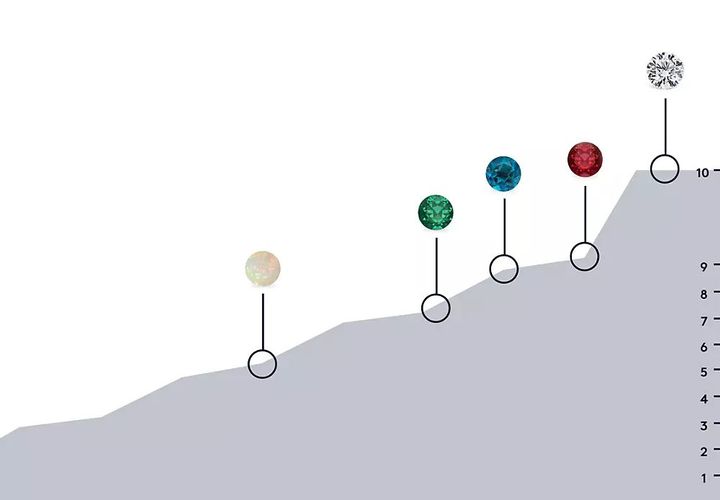
Enhancements
A variety of gemstone enhancements can be used on diamonds to emphasize their color or enhance their clarity. Irradiation, high pressure, high temperature (HPHT) and coatings are all treatments that can adjust a diamond’s color. Fracture filling can minimize the appearance of white fractures in a diamond. Laser drilling to remove imperfections can improve the look of a diamond’s clarity.
The most common treatment for sapphires is heat to emphasize their color and reduce the appearance of inclusions for increased clarity.
Meanings and Symbolism
Diamonds are a classic symbol of love everlasting. As the world’s hardest substance, they carry a sense of timelessness and strength. Clear stones also symbolize purity.
Sapphires are often equated with knowledge and wisdom and are a symbol of good choices, adding to their significance as an engagement stone. They also are thought to connect you to the universe and bring good fortune into your relationship.
Shop Popular Sapphire Rings
Popular Ring Styles and Settings
Diamonds are beautifully versatile and look stunning in a wide range of cuts. The best cut for a stone allows optimal light reflection and suits its natural shape and qualities. A classic round cut is a favorite, as it highlights the sparkle of the highly refractive stone, but there are plenty of stunning options to choose from when looking for the ideal diamond.
Sapphires also come in a beautiful variety of cuts, with the most popular being round, oval and cushion cuts. The best cuts are designed to flatter the natural balance of the stone and give it an even look.
Both diamonds and sapphires look lovely in an array of different settings, so there’s plenty of room to let your creativity come to life when deciding on an ideal style. Select a solitaire-set stone to make a timeless statement, choose a pavé or halo setting to accentuate the main stone with dramatic shimmer, or opt for beautiful accent stones.
Sapphire vs Diamond Weight
When looking at sapphire vs diamond weight, there are major differences between these two stones. Carat refers to the weight of a gemstone and is often used to determine stone size. Sapphires are typically denser than diamonds, giving them a heavier carat weight for a visually smaller stone. A 1 carat sapphire will look smaller than a 1 carat diamond of a similar cut due to the increased density of sapphires.
Chemical Differences
Diamonds are made of carbon that has been exposed to incredible pressure and heat, resulting in an isometric atom structure that helps give diamonds their hardness.
Sapphires are chemically different from diamonds, featuring corundum that contains only oxygen and aluminum. The environment where sapphires grow is very uncommon, as the oxygen and aluminum must combine without any silicon present. This makes sapphires rarer than diamonds.
Sapphire vs Diamond Price
Though sapphires are rarer than diamonds, they are often a more affordable diamond alternative or accent. The brilliance, durability and timelessness of diamonds keeps them as the more expensive of these two gems. A diamond of similar carat, cut and quality will cost more than a comparable sapphire.
Popularity of Diamonds vs Sapphires
The sapphire vs diamond debate has been continuing for years, with people enjoying the beauty of both these stones. Sapphires are growing in popularity for all jewelry types, including pink sapphire engagement rings. Many pieces also combine sapphires and diamonds into one beautiful design.
Blue Nile Promise
Whether you’re seeking a dreamy blue sapphire, a fiery diamond, or you're still seeking information about other gemstones to create the perfect ring, we’re here to help. From complimentary ring sizing to free returns, we have a variety of services to ensure you’re as thrilled with your ring as you should be. We also offer complimentary cleaning services, once you’ve found the right ring, to help you keep it looking as stunning as when you first saw it.
Sapphire vs Diamond FAQs
Is sapphire a diamond?
No, a sapphire is not a diamond. Diamonds are made from carbon while sapphires are a mineral known as corundum. They have uniquely different chemical compositions and styles.
Is sapphire better than diamond?
Sapphires and diamonds both bring their own features and benefits. The “better” stone is the one that meets your budget and style.
Is sapphire more expensive than diamond?
When comparing sapphires vs diamonds price, diamonds are the more expensive stone. Though sapphires are rarer than diamonds, they are less expensive.
Can you tell the difference between sapphire and diamond?
Sapphires and diamonds typically come in different colors. When comparing similarly colored stones, such as white sapphires vs diamonds, brilliance is one of the best ways to differentiate between the two. A diamond will return a brilliant, fiery sparkle while the brilliance of sapphires is more often a milky sparkle.
What is the best way to clean sapphire jewelry?
Sapphires require regular cleaning to stay at their best sparkle. Polishing the sapphire and cleaning off any buildup with a jewelry cleaning solution will keep the stone at its best.
How Do Other Gemstones Compare to Diamonds?
Only at Blue Nile
When it comes to celebrations we strive to make your experience as
brilliant as our jewelry with the perfect pieces for every occasion.
Meet our personal jewelers, explore bestselling styles, pick up an online order, arrange to preview something from our online collection and so much more.
Book a fun and interactive appointment with a diamond expert and get up-close views of diamond and jewelery options from the comfort of your own home.
Amazing Value
The highest-quality design at a great price.
Peace of Mind
30-day returns, diamond price-match guarantee and more.
Expert Guidance
The original online jeweler since 1999.
Inspiring Assortment
The perfect pieces for every occasion.
